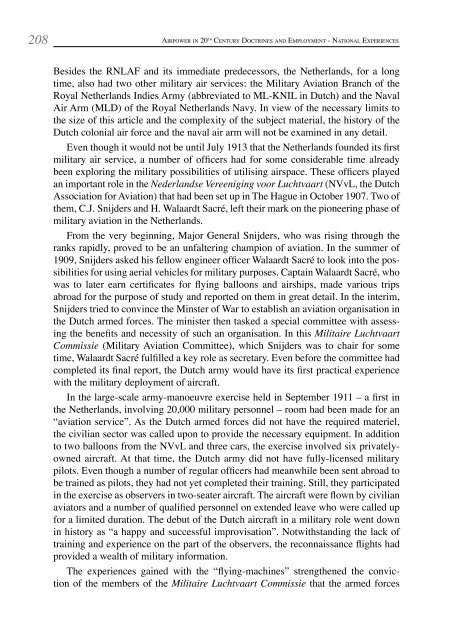National Experiences - British Commission for Military History
National Experiences - British Commission for Military History
National Experiences - British Commission for Military History
Create successful ePaper yourself
Turn your PDF publications into a flip-book with our unique Google optimized e-Paper software.
208 ai r p o w e r in 20 t H Ce n t u ry do C t r i n e s a n d em p l o y m e n t - nat i o n a l ex p e r i e n C e s<br />
Besides the RNLAF and its immediate predecessors, the Netherlands, <strong>for</strong> a long<br />
time, also had two other military air services: the <strong>Military</strong> Aviation Branch of the<br />
Royal Netherlands Indies Army (abbreviated to ML-KNIL in Dutch) and the Naval<br />
Air Arm (MLD) of the Royal Netherlands Navy. In view of the necessary limits to<br />
the size of this article and the complexity of the subject material, the history of the<br />
Dutch colonial air <strong>for</strong>ce and the naval air arm will not be examined in any detail.<br />
Even though it would not be until July 1913 that the Netherlands founded its first<br />
military air service, a number of officers had <strong>for</strong> some considerable time already<br />
been exploring the military possibilities of utilising airspace. These officers played<br />
an important role in the Nederlandse Vereeniging voor Luchtvaart (NVvL, the Dutch<br />
Association <strong>for</strong> Aviation) that had been set up in The Hague in October 1907. Two of<br />
them, C.J. Snijders and H. Walaardt Sacré, left their mark on the pioneering phase of<br />
military aviation in the Netherlands.<br />
From the very beginning, Major General Snijders, who was rising through the<br />
ranks rapidly, proved to be an unfaltering champion of aviation. In the summer of<br />
1909, Snijders asked his fellow engineer officer Walaardt Sacré to look into the possibilities<br />
<strong>for</strong> using aerial vehicles <strong>for</strong> military purposes. Captain Walaardt Sacré, who<br />
was to later earn certificates <strong>for</strong> flying balloons and airships, made various trips<br />
abroad <strong>for</strong> the purpose of study and reported on them in great detail. In the interim,<br />
Snijders tried to convince the Minster of War to establish an aviation organisation in<br />
the Dutch armed <strong>for</strong>ces. The minister then tasked a special committee with assessing<br />
the benefits and necessity of such an organisation. In this Militaire Luchtvaart<br />
Commissie (<strong>Military</strong> Aviation Committee), which Snijders was to chair <strong>for</strong> some<br />
time, Walaardt Sacré fulfilled a key role as secretary. Even be<strong>for</strong>e the committee had<br />
completed its final report, the Dutch army would have its first practical experience<br />
with the military deployment of aircraft.<br />
In the large-scale army-manoeuvre exercise held in September 1911 – a first in<br />
the Netherlands, involving 20,000 military personnel – room had been made <strong>for</strong> an<br />
“aviation service”. As the Dutch armed <strong>for</strong>ces did not have the required materiel,<br />
the civilian sector was called upon to provide the necessary equipment. In addition<br />
to two balloons from the NVvL and three cars, the exercise involved six privatelyowned<br />
aircraft. At that time, the Dutch army did not have fully-licensed military<br />
pilots. Even though a number of regular officers had meanwhile been sent abroad to<br />
be trained as pilots, they had not yet completed their training. Still, they participated<br />
in the exercise as observers in two-seater aircraft. The aircraft were flown by civilian<br />
aviators and a number of qualified personnel on extended leave who were called up<br />
<strong>for</strong> a limited duration. The debut of the Dutch aircraft in a military role went down<br />
in history as “a happy and successful improvisation”. Notwithstanding the lack of<br />
training and experience on the part of the observers, the reconnaissance flights had<br />
provided a wealth of military in<strong>for</strong>mation.<br />
The experiences gained with the “flying-machines” strengthened the conviction<br />
of the members of the Militaire Luchtvaart Commissie that the armed <strong>for</strong>ces



